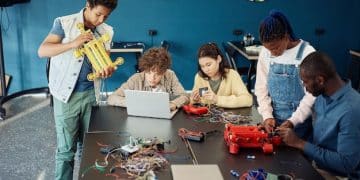The Future of College Education: Trends Shaping Higher Learning in 2025

The Future of College Education: Trends Shaping Higher Learning in 2025 will be molded by technology, personalized learning, and accessibility improvements. These elements will reshape higher education’s landscape, producing more dynamic and efficient learning environments.
The landscape of higher education is constantly shifting, and predicting the future of college is more important than ever. As we approach 2025, several key trends are poised to revolutionize how students learn, how institutions operate, and what the overall college experience will entail. From technological innovations to evolving pedagogical approaches, understanding these trends is crucial for students, educators, and policymakers alike. The future of college education: trends shaping higher learning in 2025 promises a more dynamic, accessible, and personalized learning environment.
Evolving Learning Models
The way students learn is undergoing a significant transformation. Traditional lecture-based models are gradually giving way to more interactive, personalized, and flexible approaches. This shift is driven by the recognition that every student learns differently and that a one-size-fits-all approach is no longer effective.
Personalized Learning
Personalized learning tailors the educational experience to meet the individual needs and goals of each student. This approach uses data and technology to identify learning gaps, strengths, and preferences, allowing educators to customize content and delivery methods accordingly.
Flexible Learning Paths
The traditional four-year degree is no longer the only path to success. Flexible learning paths, such as micro-credentials, online courses, and competency-based education, are becoming increasingly popular. These options allow students to acquire skills and knowledge at their own pace and on their own terms.
- Micro-credentials: Focused, skill-based certifications that validate specific competencies.
- Online Courses: Accessible and often more affordable, providing flexibility in scheduling and location.
- Competency-Based Education: Emphasizes mastery of skills rather than seat time, allowing quicker progression.
These evolving models aim to make education more relevant, efficient, and accessible for a diverse range of students, accommodating different learning styles and life circumstances.

Technological Integration
Technology is at the forefront of the changes occurring in higher education. From online learning platforms to advanced research tools, technology is enhancing every aspect of the college experience. The integration of technology is not just about convenience; it’s about creating more engaging, efficient, and effective learning environments.
Artificial Intelligence (AI) in Education
AI is being used in various ways to improve learning outcomes. AI-powered tutoring systems provide personalized feedback and support, while AI-driven analytics help educators identify students who may be struggling. Additionally, AI is automating administrative tasks, freeing up faculty to focus on teaching and research.
Virtual and Augmented Reality (VR/AR)
VR and AR technologies are transforming how students interact with course material. VR allows students to immerse themselves in virtual environments, such as historical sites or scientific simulations, while AR overlays digital information onto the real world, enhancing hands-on learning experiences.
- Interactive Simulations: VR allows students to conduct experiments in a safe, virtual environment.
- Enhanced Visualization: AR brings abstract concepts to life, making them easier to understand.
- Remote Collaboration: VR/AR facilitates virtual teamwork and collaborative projects.
By leveraging these technologies, colleges can offer more dynamic, engaging, and effective learning experiences that prepare students for the demands of the modern workforce.
Focus on Skills and Employability
There’s a growing emphasis on aligning college curricula with the demands of the job market. Students and their families are increasingly focused on the return on investment (ROI) of a college education, and institutions are responding by prioritizing skills development and career readiness.
Industry Partnerships
Colleges are forming partnerships with businesses and organizations to offer internships, mentorship programs, and real-world projects. These collaborations provide students with valuable hands-on experience and help them build professional networks.
Emphasis on Soft Skills
In addition to technical skills, employers are increasingly valuing soft skills such as communication, teamwork, and problem-solving. Colleges are incorporating these skills into their curricula through group projects, public speaking opportunities, and leadership development programs.

The integration of industry insights and the emphasis on soft skills prepare graduates not only with theoretical knowledge but also with the practical skills and attributes necessary to succeed in their chosen careers.
The Rise of Online and Hybrid Learning
Online learning has been on the rise for years, but the COVID-19 pandemic accelerated its adoption. While many institutions have returned to in-person instruction, the lessons learned during the pandemic are shaping the future of college education. Hybrid learning models, which combine online and in-person components, are becoming increasingly popular. These models offer flexibility and convenience while still providing opportunities for face-to-face interaction.
- Asynchronous Learning: Allows students to access course materials and complete assignments on their own schedule.
- Synchronous Learning: Involves real-time interaction through video conferencing, live lectures, and virtual discussions.
- Blended Courses: Integrate online and in-person activities to maximize engagement and learning outcomes.
Hybrid learning models are gaining traction because they offer a balanced approach, appealing to both students who prefer the flexibility of online learning and those who value the social and interactive aspects of in-person instruction.
Increased Accessibility and Affordability
One of the biggest challenges facing higher education is the rising cost of tuition. As a result, there is a growing movement to make college more accessible and affordable for students of all backgrounds. Initiatives such as tuition-free college programs, open educational resources (OER), and innovative funding models are gaining momentum.
Open Educational Resources (OER)
OER are freely available educational materials that can be used and adapted by educators and students. These resources can significantly reduce the cost of textbooks and other course materials, making college more affordable.
Innovative Funding Models
Income Share Agreements (ISAs) are an alternative to traditional student loans. Under an ISA, students agree to pay a percentage of their income for a set period of time after graduation, rather than taking on debt. This model aligns the interests of students and institutions, as colleges are incentivized to ensure that graduates are successful.
These efforts to address affordability and accessibility are crucial to ensuring that higher education remains a pathway to opportunity for all, regardless of socioeconomic background.
Diversity, Equity, and Inclusion (DEI)
Colleges and universities are increasingly focused on creating diverse, equitable, and inclusive campuses. This includes recruiting and supporting students from underrepresented backgrounds, fostering a welcoming and inclusive environment, and incorporating diverse perspectives into the curriculum. DEI initiatives are not just about social justice; they are also about preparing students to succeed in a diverse and global workforce.
Inclusive Curriculum
An inclusive curriculum reflects the diverse experiences and perspectives of all students. Colleges are incorporating diverse voices into their courses, using inclusive teaching methods, and creating opportunities for students to learn about different cultures and backgrounds.
Support Services for Underrepresented Students
Colleges are providing support services tailored to meet the needs of underrepresented students, such as mentoring programs, cultural centers, and financial aid assistance. These services help students overcome barriers to success and create a more equitable campus environment.
By prioritizing DEI, colleges can create a more enriching and equitable learning environment for all students, preparing them to be responsible and engaged citizens in an increasingly diverse world.
| Key Point | Brief Description |
|---|---|
| 🚀 Personalized Learning | Tailoring education to individual student needs. |
| 💡 Tech Integration | Using AI and VR/AR to enhance learning. |
| 💼 Skills & Employability | Focusing on industry partnerships and soft skills. |
| 🌍 DEI Initiatives | Promoting diversity, equity, and inclusion on campus. |
Frequently Asked Questions
▼
AI will personalize learning through intelligent tutoring systems and predictive analytics. It will also automate administrative tasks, allowing educators to focus more on teaching and student support. AI can offer customized study plans based on individual progress.
▼
VR/AR technologies will create immersive learning experiences, allowing students to explore virtual environments and interact with complex concepts in a more engaging way. This technology can be used for simulations, historical reconstructions, and interactive lessons.
▼
Colleges can reduce costs by adopting open educational resources (OER), which are free to use and adapt. Income Share Agreements (ISAs) provide an alternative to traditional student loans, aligning institutional success with student outcomes. Promoting dual enrollment programs also helps.
▼
DEI initiatives create a more inclusive and equitable environment for students from all backgrounds. These efforts prepare students to succeed in a diverse global workforce and foster a sense of belonging and mutual respect, contributing to their success.
▼
Micro-credentials are focused, skill-based certifications that validate specific competencies. They are valuable because they allow students to acquire in-demand skills quickly and efficiently, enhancing their employability and career prospects. They often focus on very specific capabilities.
Conclusion
As we look toward 2025, the future of college education: trends shaping higher learning in 2025 will be defined by innovation, flexibility, and a commitment to student success. Embracing these trends will be crucial for institutions looking to remain relevant and competitive in the evolving landscape of higher education.





